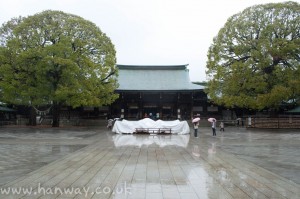
A Temple and a Shrine – Tokyo
I visited a temple and a shrine on consecutive days in Tokyo, but figured it would make sense to fold both into this one short post.
The Senso-Ji is found at Asakusa in the Taito district of Tokyo. It’s surrounded by a permanent market selling sweets and niknaks. I was able to pick up some (probably overpriced) woodcut reprints as I made my way towards the temple. On the approach to the temple, I had another go with my Neutral Density Filter. This time trying to stand very still as the crowds flowed around me like water:
There was a curious contrast between the noise, laughter and playfulness outside and inside the temple and the solemnity at the altar of the temple. This is quite in contrast to how things seem to be in non happy-clappy churches in Europe, where there is a library-like mumbling near-silence, even in a big tourist destination like St. Paul’s or St. Peter’s.
Inside the temple was an opportunity to have your fortune told (100 Yen or 80p). Pay your money, shake the box (politely!), take a stick from the box and open the relevant drawer. You can take the fortune home if it’s a good one. If it’s bad, you can tie it to a specially-provided wire fence to leave your bad luck behind you.
Mine was “No.25 Regular Fortune”, which promised me:
When spring comes, all trees and grasses are in full bloom. Everything will go good, then you will be happier in the future. When you get the archery of the big warrior general, your happiness it reassure, wealth will grow large as to have to carry by coach.
Far different was the Meiji Shrine in Shibuya. The shrine is dedicated to the Emperor Meiji and his wife. During Meiji’s reign, Japan jumped from a pre-industrial, feudal country to an industrialised great power that had bloodied Russia’s nose.
The area around the Shrine park is busy, consumerist, loud and garish. As you pass through the Torii gate, this is left behind and instead you’re in a peaceful forest.
The approach up to the shrine is lined with Sake barrels, a traditional offering at shrines. Also present are barrels of French wine – the Emperor cultivated European tastes as well as traditional Japanese.
Just outside the entrance was a stall selling amulets for various purposes, such as: success in exams, fertility, love, work success.
Passing through the gatehouse was the shrine itself. No photography was allowed at the shrine, and it was policed. At festivals, crowds gather and throw offerings into the fountain (usually money). The fountain was covered with white tarpaulin when we visited.
With me was Akio, a friend of a friend, who had kindly given up some of his time the previous night to teach me about Yakitori and Sake, and was today explaining the shrine and its surroundings.
Beside the shrine was a place where requests of the spirits written on wood were hung. Most were in Japanese, but some were in other languages.








